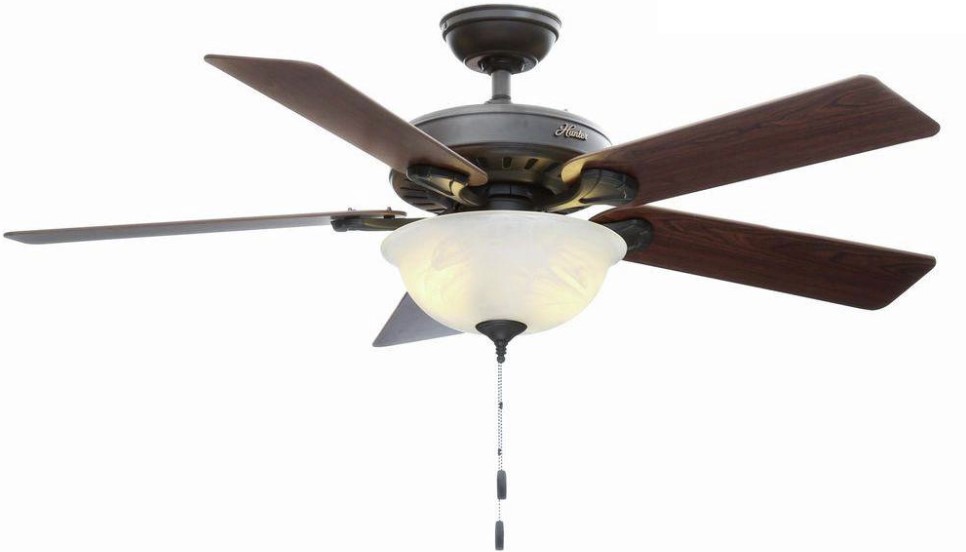The Hunter ceiling fan offers a convenient and cost-effective way of keeping your home cool, especially if you do not have an AC. It can distribute both cold and hot air and maintain the right temperature.
But regardless of its benefits, it can sometimes break down and fail to work well. If you encounter a problem with the machine, follow these carefully crafted Hunter ceiling fan troubleshooting tips to pinpoint and fix the problem.

Problems with the Hunter ceiling fan can range from clicking noise to the fan not working on all speeds and failure to power up.
Sometimes the machine can stop working because of an overheated fan or an internal defect like shot ball bearings.
However, unless you know the primary cause of the issue, you will be unable to fix it in the right way. Here are some of the most common problems with the Hunter ceiling fan and how to fix them.
Contents
Hunter ceiling fan remote control won’t work
You can troubleshoot the Hunter ceiling fan remote by following the methods below.
- Change the batteries and try again or check that you have installed them properly
- Check that the dip switches on the fan receiver and remote are on the same frequency.
The switches look like four sliding buttons that also appear on the back of the remote. Both should have the same frequency for the remote control to work. Here’s a detailed guide for resetting a ceiling fan remote.
How to reset a Hunter ceiling fan
If you want to reset a Hunter ceiling fan:
- Press and hold the power button on your remote for about five seconds
- Wait for LED lights to blink
- Wait for 30 seconds after the blink and press any button
- You will hear a beeping sound, and the lights will blink continuously.
Once the LED stops blinking, you will have completed the reset. A reset is helpful if you have gone through several solutions to fix the Hunter fan not working problem.
The ceiling fan blades are wobbling
If the machine is wobbly:
- Use a screwdriver to tighten the screw blades
- Check if the machine’s hanger ball is in good order or well-seated in the canopy
If the wobbling is too much while running, install a balancing kit.
The kit usually comes with the entire packaging during purchase, including a user manual. Follow the instructions to install it.
The fan light doesn’t work
If the fan light stopped working after a power outage, the problem could be a faulty light kit or a blown fuse. In that case, you will need to replace it.
It can also stop working because you have a faulty remote control, which could either be the receiver or the handset itself.
Fix this issue by ensuring both the receiver and the handset are on the same frequency.
A broken light switch and incorrect installation are other reasons. You can fix both of these by changing the light switch and installing the lights correctly.
Hunter ceiling fan overheats while in use
The advantage of Hunter ceiling fans is that they can run for years without overheating. You only need to turn it off to clean it regularly.
But like all other electric products, heating is usually a sign of the work done on the machine. More work equals more heat.
It can overheat if you set it to high speeds. In that case, reduce the speed. If the blades are not moving freely, it will cause overheating. Another reason could be a motor failure. The best solution is to contact a professional to fix it.
Troubleshooting a ceiling fan that makes noises
If you notice the machine makes grinding noise or any other noise, here is what you can do:
- Check whether some screws are loosely tight and tighten them
- If the fan is old, the motor laminates could be breaking down
- Check whether you have cracked blades and replace them
- The light fixture glass may not be secure and their screws need tightening
Also, check to ensure that the blades are moving freely. It is helpful to do Hunter ceiling fan repairs after the machine runs for at least 6-12 months.
Wrapping things up
If the Hunter fan won’t turn off when using a remote, the problem could be the batteries or the dip switches on the remote and fan are not on the same frequency.
When you notice a grinding noise, ensure the blades are moving freely. If you encounter other issues that this Hunter ceiling fan troubleshooting guide doesn’t cover, contact a technician for further assistance.
Related Articles
